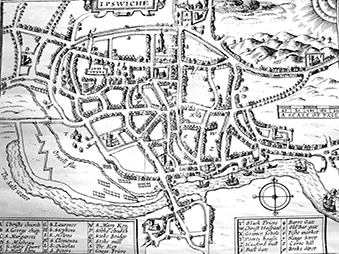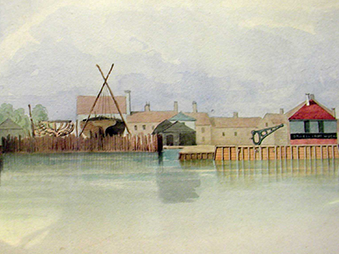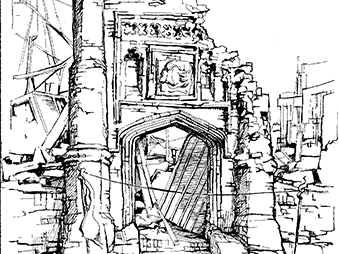There have been four phases of archaeological investigation in the town. Find out more below.
Phase 1 1850 - 1950
Pottery and artefacts recovered from developments in the town were collected throughout this period by the Borough Museum, which opened in 1847. Some derived from watching briefs carried out by Nina Layard, who was one of the first four women to be admitted as a Fellow of the Society of Antiquaries of London. Layard's work included monitoring the construction of the first town sewers in 1884 and the redevelopment of the Carmelite Friary site and quay in 1899, as well as excavating the important Early Saxon cemetery at Hadleigh Road. The important Roman Villa at Castle Hill, discovered in the 19th century was excavated by Basil Brown in the 1940s.
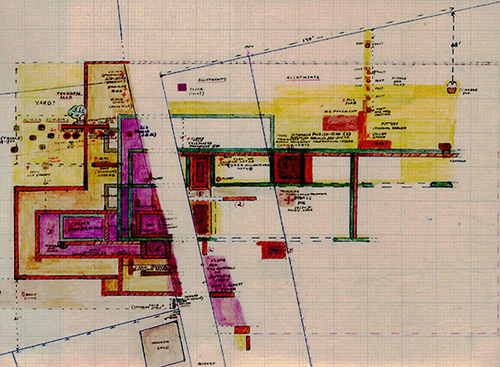
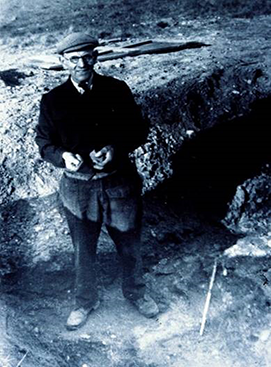
Image (left): Illustrated plan of Castle Hill Roman villa by Basil Brown in 1940. Image (right): Photo of Basil Brown (1888-1977) (copyright SCCAS)
Phase 2 1950 - 1974
In the late 1950s, the large pottery collection at the museum was studied by John Hurst and Stanley West. They concluded that most of it was Saxon and made in the town (Hurst and West 1957). The earliest pottery, which they termed Ipswich ware, was dated to the Middle Saxon period (c. 650-c. 850 AD) and this was followed by Thetford ware from c.850-1150 (so-called as it was first recognised in Thetford). During this phase, Ipswich Museum took a more active interest in the archaeology of the town. Watching briefs were carried out during developments at the Ipswich Co-Operative Society premises in Carr Street and on the site of the West Gate. The first professional and government-funded excavations were carried out by Stanley West at Cox Lane in 1958 and Shire Hall Yard in 1959. West established that Ipswich was a large settlement, covering at least 30 hectares, and an international port during the Middle Saxon period.
In the early 1970s it became clear that Ipswich was one of only a handful of trading settlements displaying urban characteristics (emporia) in North-Western Europe during this period. This elevated the town’s archaeological status to one of international importance. At the same time, the Scole Committee identified that the archaeology of Ipswich was under serious threat from a potential development boom and lobbied for the government and local authorities to make provision for its ‘rescue’.
Phase 3 1974 - 1990 Excavation Archive Project
In 1974, the Suffolk Archaeological Unit was created, initially under the management of the Scole Committee for East Anglian Archaeology, and then Suffolk County Council. The Unit provided a countywide rescue archaeology service. Keith Wade was appointed to the post of urban archaeologist to monitor development in all the urban centres of Suffolk, with special reference to Ipswich.
The Ipswich excavations formed part of a wider programme of research called The Origins of Ipswich Project, which included documentary research and the recording of standing buildings. Funding for this work came originally from archaeological grants from the Department of Environment, Inspectorate of Ancient Monuments, and was supplemented later by Manpower Service Commission schemes, utilising firstly school leavers (Youth Opportunities Programme) and then unemployed young adults (Community Programme). From 1987, three years before the introduction of national planning policy (Planning Policy Guidance: Archaeology and Planning (PPG) 16), limited developer funding became more available to supplement the Government and Manpower Service Commission money.
The sampling strategy established for the excavation programme was achieved over a sixteen-year period. A total of thirty-six archaeological excavations took place between 1974 and 1990. All the sites lay within the historic core of the town, with 27 inside the Saxon and medieval defences and nine within the medieval suburbs. All the excavations were supervised by Tom Loader or John Newman under the overall directorship of Keith Wade. Unfortunately, none of these excavations have been fully published to date. However, extensive post excavation analysis was completed, and the complete archive is now accessible via the Archaeology Data Service (ADS) website. Short site summaries were published in the annual ‘Archaeology in Suffolk’ section of the Proceedings of the Suffolk Institute of Archaeology and History and short reports in East Anglian Archaeology. Synthetic works have also been produced and the earliest phase of the St Stephens Lane / Buttermarket sites (the 7th century cemetery) was fully published. Some reports on the Middle Saxon finds have also been published by the specialists, such as the pottery and faunal remains.
Take a look at the Excavation Archive Report
between 1974 and 1990, 36 excavations on 34 sites took place in Ipswich
Find Out More »Phase 4 1991 - 2012
Image: Excavations at Stoke Key by Commercial Archaeological Contractors in 2012
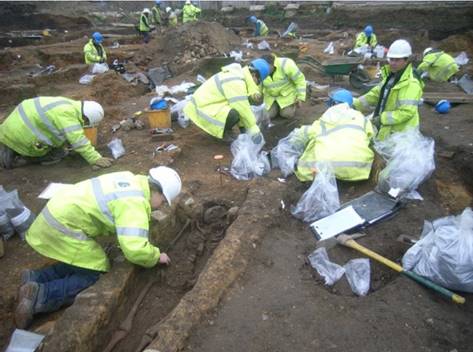 From 1991 onwards, all excavations were developer-funded following new planning guidance (PPG 16). The excavation of sites is now the subject of competitive tendering by developers and many local and national archaeological contractors are now undertaking most of the work in the town. There was very little development in the town over this period, apart from the redevelopment of the Ipswich docks, which was cut short by the financial crash after 2008. Important sites were excavated along the waterfront, but as most of the developers went into liquidation, none of the sites have been analysed or published. Currently, as the economy starts to recover, excavation work is starting again. A large site was excavated at Stoke Quay, south of the river, in 2012.
From 1991 onwards, all excavations were developer-funded following new planning guidance (PPG 16). The excavation of sites is now the subject of competitive tendering by developers and many local and national archaeological contractors are now undertaking most of the work in the town. There was very little development in the town over this period, apart from the redevelopment of the Ipswich docks, which was cut short by the financial crash after 2008. Important sites were excavated along the waterfront, but as most of the developers went into liquidation, none of the sites have been analysed or published. Currently, as the economy starts to recover, excavation work is starting again. A large site was excavated at Stoke Quay, south of the river, in 2012.
Archaeological work continues in Ipswich ahead of development as part of the planning process.
More information can be found in the Supplementary Planning Document.
